| Drug status | DrugBank ID | Name | Type | Drug structure |
| Experimental | DB02091 | 4-(2,4-Dimethyl-Thiazol-5-Yl)-Pyrimidin-2-Ylamine | Small molecule |  |
| Experimental | DB02407 | 6-O-Cyclohexylmethyl Guanine | Small molecule |  |
| Experimental | DB02833 | [4-(2-Amino-4-Methyl-Thiazol-5-Yl)-Pyrimidin-2-Yl]-(3-Nitro-Phenyl)-Amine | Small molecule | 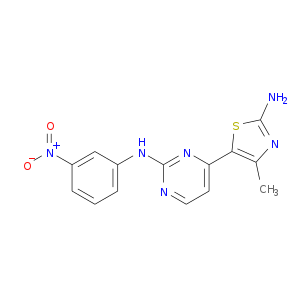 |
| Experimental | DB02915 | 4-(2,4-Dimethyl-Thiazol-5-Yl)-Pyrimidin-2-Yl]-(4-Trifluoromethyl-Phenyl)-Amine | Small molecule |  |
| Experimental | DB06844 | 4-[(7-OXO-7H-THIAZOLO[5,4-E]INDOL-8-YLMETHYL)-AMINO]-N-PYRIDIN-2-YL-BENZENESULFONAMIDE | Small molecule |  |
| Experimental | DB06944 | N-(3-cyclopropyl-1H-pyrazol-5-yl)-2-(2-naphthyl)acetamide | Small molecule | 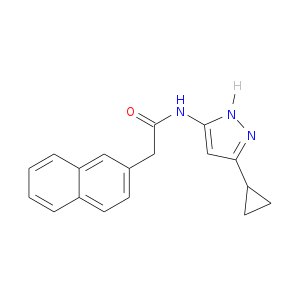 |
| Experimental | DB06948 | 2-ANILINO-6-CYCLOHEXYLMETHOXYPURINE | Small molecule | 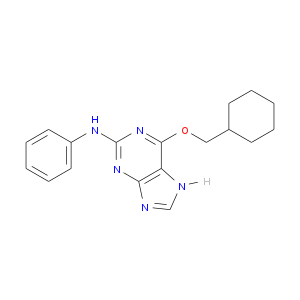 |
| Experimental | DB07126 | O6-CYCLOHEXYLMETHOXY-2-(4'-SULPHAMOYLANILINO) PURINE | Small molecule | 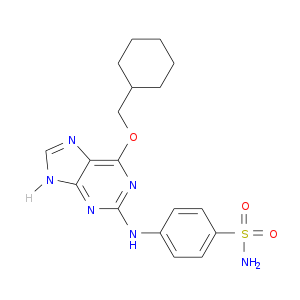 |
| Experimental | DB07137 | (2S)-N-[(3Z)-5-CYCLOPROPYL-3H-PYRAZOL-3-YLIDENE]-2-[4-(2-OXOIMIDAZOLIDIN-1-YL)PHENYL]PROPANAMIDE | Small molecule | 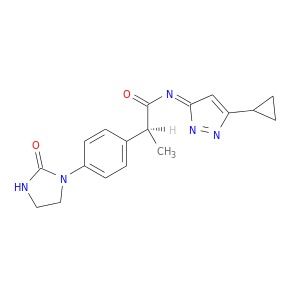 |
| Experimental | DB07164 | N-cyclopropyl-4-pyrazolo[1,5-b]pyridazin-3-ylpyrimidin-2-amine | Small molecule | 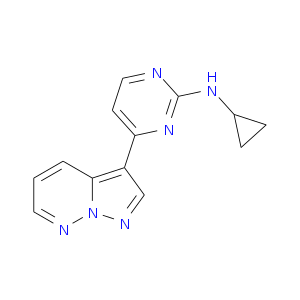 |
| Experimental | DB07203 | 6-CYCLOHEXYLMETHOXY-2-(3'-CHLOROANILINO) PURINE | Small molecule | 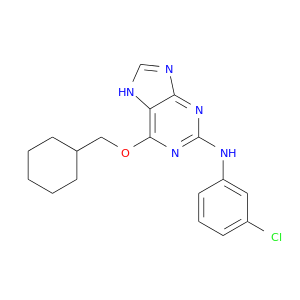 |
| Experimental | DB07471 | 5-[5,6-BIS(METHYLOXY)-1H-BENZIMIDAZOL-1-YL]-3-{[1-(2-CHLOROPHENYL)ETHYL]OXY}-2-THIOPHENECARBOXAMIDE | Small molecule |  |
| Experimental | DB07533 | 4-{5-[(Z)-(2-IMINO-4-OXO-1,3-THIAZOLIDIN-5-YLIDENE)METHYL]-2-FURYL}-N-METHYLBENZENESULFONAMIDE | Small molecule |  |
| Experimental | DB07534 | 4-{5-[(Z)-(2-IMINO-4-OXO-1,3-THIAZOLIDIN-5-YLIDENE)METHYL]FURAN-2-YL}BENZENESULFONAMIDE | Small molecule | 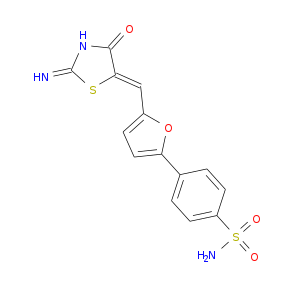 |
| Experimental | DB07538 | 4-{5-[(Z)-(2-IMINO-4-OXO-1,3-THIAZOLIDIN-5-YLIDENE)METHYL]FURAN-2-YL}-2-(TRIFLUOROMETHYL)BENZENESULFONAMIDE | Small molecule | 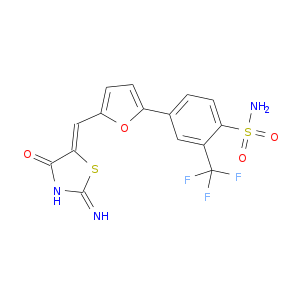 |
| Experimental | DB07539 | 4-{5-[(Z)-(2-IMINO-4-OXO-1,3-THIAZOLIDIN-5-YLIDENE)METHYL]FURAN-2-YL}BENZOIC ACID | Small molecule | 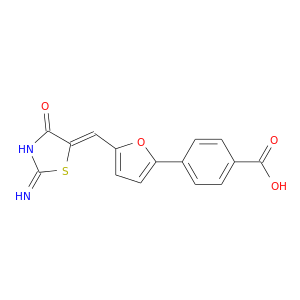 |
| Experimental | DB07562 | N-[4-(2,4-DIMETHYL-THIAZOL-5-YL)-PYRIMIDIN-2-YL]-N',N'-DIMETHYL-BENZENE-1,4-DIAMINE | Small molecule | 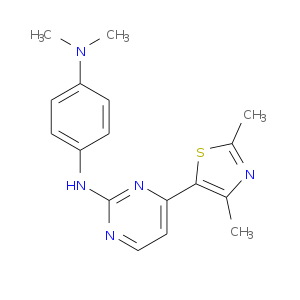 |
| Experimental | DB07688 | 4-{[5-(CYCLOHEXYLOXY)[1,2,4]TRIAZOLO[1,5-A]PYRIMIDIN-7-YL]AMINO}BENZENESULFONAMIDE | Small molecule |  |
| Experimental | DB07852 | 1-(3,5-DICHLOROPHENYL)-5-METHYL-1H-1,2,4-TRIAZOLE-3-CARBOXYLIC ACID | Small molecule | 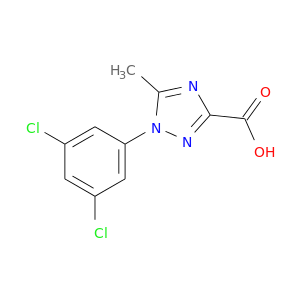 |
| Experimental | DB08178 | 4-(4-methoxy-1H-pyrrolo[2,3-b]pyridin-3-yl)pyrimidin-2-amine | Small molecule | 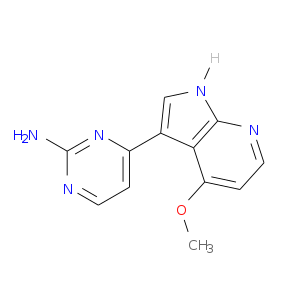 |
| Experimental | DB08182 | 4-(4-propoxy-1H-pyrrolo[2,3-b]pyridin-3-yl)pyrimidin-2-amine | Small molecule |  |
| Experimental | DB08218 | HYDROXY(OXO)(3-{[(2Z)-4-[3-(1H-1,2,4-TRIAZOL-1-YLMETHYL)PHENYL]PYRIMIDIN-2(5H)-YLIDENE]AMINO}PHENYL)AMMONIUM | Small molecule |  |
| Experimental | DB08219 | 4-METHYL-5-{(2E)-2-[(4-MORPHOLIN-4-YLPHENYL)IMINO]-2,5-DIHYDROPYRIMIDIN-4-YL}-1,3-THIAZOL-2-AMINE | Small molecule |  |
| Experimental | DB08233 | 6-CYCLOHEXYLMETHYLOXY-2-(4'-HYDROXYANILINO)PURINE | Small molecule | 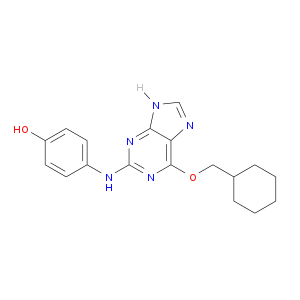 |
| Experimental | DB08241 | 4-(6-CYCLOHEXYLMETHOXY-9H-PURIN-2-YLAMINO)--BENZAMIDE | Small molecule | 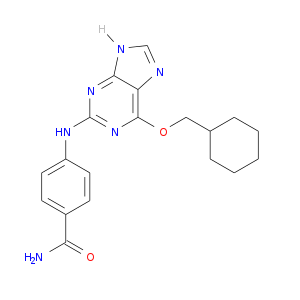 |
| Experimental | DB08248 | 3-(6-CYCLOHEXYLMETHOXY-9H-PURIN-2-YLAMINO)-BENZENESULFONAMIDE | Small molecule |  |
| Experimental | DB08285 | (2R)-2-{[4-(benzylamino)-8-(1-methylethyl)pyrazolo[1,5-a][1,3,5]triazin-2-yl]amino}butan-1-ol | Small molecule | 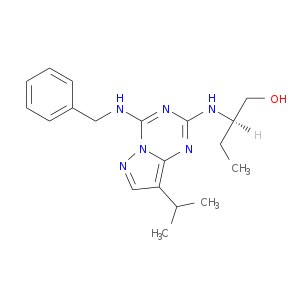 |
| Experimental | DB08309 | 3-({2-[(4-{[6-(CYCLOHEXYLMETHOXY)-9H-PURIN-2-YL]AMINO}PHENYL)SULFONYL]ETHYL}AMINO)PROPAN-1-OL | Small molecule |  |
| Experimental | DB08355 | 1-methyl-8-(phenylamino)-4,5-dihydro-1H-pyrazolo[4,3-h]quinazoline-3-carboxylic acid | Small molecule |  |
| Experimental | DB08463 | (2R)-2-({9-(1-methylethyl)-6-[(4-pyridin-2-ylbenzyl)amino]-9H-purin-2-yl}amino)butan-1-ol | Small molecule | 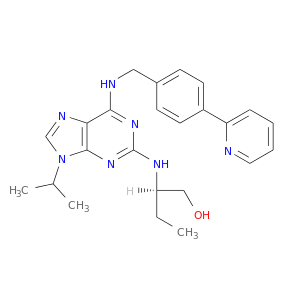 |
| Experimental | DB08527 | 1-[4-(AMINOSULFONYL)PHENYL]-1,6-DIHYDROPYRAZOLO[3,4-E]INDAZOLE-3-CARBOXAMIDE | Small molecule |  |
| Experimental | DB08572 | 4-{[4-AMINO-6-(CYCLOHEXYLMETHOXY)-5-NITROSOPYRIMIDIN-2-YL]AMINO}BENZAMIDE | Small molecule |  |
| Experimental | DB08694 | 9-amino-5-(2-aminopyrimidin-4-yl)pyrido[3',2':4,5]pyrrolo[1,2-c]pyrimidin-4-ol | Small molecule |  |
| Ligand ID | Ligand short name | Ligand long name | PDB ID | PDB name | mutLBS |
III | | Peptide ligand (PRO,VAL,LYS,ARG,ARG,LEU,ASP,LEU,GLU) | 1h24 | B | E220 | III | | Peptide ligand (ARG,ASN,LEU,PHE,GLY,PRO) | 1h27 | B | E220 | III | | Peptide ligand (ALA,LYS,ARG,ARG,LEU,PHE,GLY,GLU) | 1h28 | D | E220 | III | | Peptide ligand (ARG,ARG,LEU,ILE,PHE,NH2) | 1okv | B | E220 | III | | Peptide ligand (ARG,ARG,LEU,ILE,PHE,NH2) | 1okv | D | E220 | III | | Peptide ligand (ACE,ARG,ARG,LEU,ASN,PHE,NH2) | 1okw | B | E220 | III | | Peptide ligand (ACE,ARG,ARG,LEU,ASN,PHE,NH2) | 1okw | D | E220 | III | | Peptide ligand (ARG,ARG,LEU,ASN,PFF,NH2) | 1ol2 | B | E220 | III | | Peptide ligand (ARG,ARG,LEU,ASN,PFF,NH2) | 1ol2 | D | E220 | III | | Peptide ligand (ACE,ARG,LYS,LEU,PHE,GLY) | 1urc | B | E220 | III | | Peptide ligand (ALA,ALA,GLU,ARG,SER,LEU,ILE,PHE,NH2) | 2c5v | B | E220 | III | | Peptide ligand (ALA,ALA,GLU,ARG,SER,LEU,ILE,PHE,NH2) | 2c5v | D | E220 | III | | Peptide ligand (HIS,THR,LEU,LYS,GLY,ARG,ARG,LEU,VAL,PHE,ASP,ASN) | 2cch | B | E220 | III | | Peptide ligand (HIS,THR,LEU,LYS,GLY,ARG,ARG,LEU,VAL,PHE,ASP,ASN) | 2cch | D | E220 | III | | Peptide ligand (THR,LEU,LYS,GLY,ARG,ARG,LEU,VAL,PHE) | 2cci | D | E220 | GVC | | 1-(3,5-DICHLOROPHENYL)-5-METHYL-1H-1,2,4-TRIAZOLE-3-CARBOXYLIC ACID | 2uue | B | E220 | GVC | | 1-(3,5-DICHLOROPHENYL)-5-METHYL-1H-1,2,4-TRIAZOLE-3-CARBOXYLIC ACID | 2uue | D | E220 | III | | Peptide ligand (ACE,ARG,ARG,LEU,PHE,NH2) | 2wfy | B | E220 | III | | Peptide ligand (ACE,ARG,ARG,LEU,PHE,NH2) | 2wfy | D | E220 | III | | Peptide ligand (ARG,ARG,LEU,PHE,NH2) | 2whb | B | E220 | III | | Peptide ligand (ARG,ARG,LEU,PHE,NH2) | 2whb | D | E220 | III | | Peptide ligand (ARG,LYS,LEU,PHE,ASN) | 2wma | B | E220 | III | | Peptide ligand (GLY,SER,ALA,LYS,ARG,ARG,LEU,PHE,GLY,GLU) | 1h28 | B | E220 Y286 | III | | Peptide ligand (HIS,THR,LEU,LYS,GLY,ARG,ARG,LEU,VAL,PHE,ASP,ASN) | 2cci | B | T207 E220 |
| LBS | AA sequence | # species | Species |
D216 | RAILVDWLVEV | 4 | Homo sapiens, Gallus gallus, Mus musculus, Bos taurus | D216 | RGILVDWLVEV | 2 | Arabidopsis thaliana, Arabidopsis thaliana | D216 | RGILIDWLVEV | 1 | Oryza sativa subsp. japonica | D283 | FVYITDDTYTK | 2 | Homo sapiens, Bos taurus | D283 | FCFITDNTYTR | 2 | Arabidopsis thaliana, Arabidopsis thaliana | D283 | FVYITDDTYNK | 1 | Gallus gallus | D283 | FVYITDDTYSK | 1 | Mus musculus | D283 | FCFITDNTYTK | 1 | Oryza sativa subsp. japonica | E220 | VDWLVEVGEEY | 4 | Homo sapiens, Gallus gallus, Mus musculus, Bos taurus | E220 | VDWLVEVSEEY | 2 | Arabidopsis thaliana, Arabidopsis thaliana | E220 | IDWLVEVSEEY | 1 | Oryza sativa subsp. japonica | E223 | LVEVGEEYKLQ | 4 | Homo sapiens, Gallus gallus, Mus musculus, Bos taurus | E223 | LVEVSEEYKLV | 1 | Oryza sativa subsp. japonica | E223 | LVEVSEEYTLA | 1 | Arabidopsis thaliana | E223 | LVEVSEEYTLV | 1 | Arabidopsis thaliana | E224 | VEVGEEYKLQN | 4 | Homo sapiens, Gallus gallus, Mus musculus, Bos taurus | E224 | VEVSEEYKLVP | 1 | Oryza sativa subsp. japonica | E224 | VEVSEEYTLAS | 1 | Arabidopsis thaliana | E224 | VEVSEEYTLVP | 1 | Arabidopsis thaliana | E269 | ASKFEEIYPPE | 4 | Homo sapiens, Gallus gallus, Mus musculus, Bos taurus | E269 | ASKYEEICAPR | 1 | Oryza sativa subsp. japonica | E269 | ASKYEEISAPR | 1 | Arabidopsis thaliana | E269 | ASKYEEIHAPR | 1 | Arabidopsis thaliana | E277 | PPEVAEFVYIT | 4 | Homo sapiens, Gallus gallus, Mus musculus, Bos taurus | E277 | APRIEEFCFIT | 2 | Arabidopsis thaliana, Arabidopsis thaliana | E277 | APRVEEFCFIT | 1 | Oryza sativa subsp. japonica | G251 | MSVLRGKLQLV | 4 | Homo sapiens, Gallus gallus, Mus musculus, Bos taurus | G251 | HYIERQKLQLL | 1 | Oryza sativa subsp. japonica | G251 | NYVQRQQLQLL | 1 | Arabidopsis thaliana | G251 | NYVERQRLQLL | 1 | Arabidopsis thaliana | I206 | K-QPDITNSMR | 2 | Homo sapiens, Bos taurus | I206 | K-QPDITNNMR | 1 | Gallus gallus | I206 | R-QPDITNSMR | 1 | Mus musculus | I206 | ALQRDITKGMR | 1 | Oryza sativa subsp. japonica | I206 | RIQKDVTQSMR | 1 | Arabidopsis thaliana | I206 | KTQRDVTETMR | 1 | Arabidopsis thaliana | I213 | NSMRAILVDWL | 3 | Homo sapiens, Mus musculus, Bos taurus | I213 | NNMRAILVDWL | 1 | Gallus gallus | I213 | KGMRGILIDWL | 1 | Oryza sativa subsp. japonica | I213 | QSMRGILVDWL | 1 | Arabidopsis thaliana | I213 | ETMRGILVDWL | 1 | Arabidopsis thaliana | I270 | SKFEEIYPPEV | 4 | Homo sapiens, Gallus gallus, Mus musculus, Bos taurus | I270 | SKYEEICAPRV | 1 | Oryza sativa subsp. japonica | I270 | SKYEEISAPRI | 1 | Arabidopsis thaliana | I270 | SKYEEIHAPRI | 1 | Arabidopsis thaliana | I281 | AEFVYITDDTY | 4 | Homo sapiens, Gallus gallus, Mus musculus, Bos taurus | I281 | EEFCFITDNTY | 3 | Oryza sativa subsp. japonica, Arabidopsis thaliana, Arabidopsis thaliana | K252 | SVLRGKLQLVG | 4 | Homo sapiens, Gallus gallus, Mus musculus, Bos taurus | K252 | YIERQKLQLLG | 1 | Oryza sativa subsp. japonica | K252 | YVQRQQLQLLG | 1 | Arabidopsis thaliana | K252 | YVERQRLQLLG | 1 | Arabidopsis thaliana | L214 | SMRAILVDWLV | 3 | Homo sapiens, Mus musculus, Bos taurus | L214 | NMRAILVDWLV | 1 | Gallus gallus | L214 | GMRGILIDWLV | 1 | Oryza sativa subsp. japonica | L214 | SMRGILVDWLV | 1 | Arabidopsis thaliana | L214 | TMRGILVDWLV | 1 | Arabidopsis thaliana | L253 | VLRGKLQLVGT | 4 | Homo sapiens, Gallus gallus, Mus musculus, Bos taurus | L253 | IERQKLQLLGI | 1 | Oryza sativa subsp. japonica | L253 | VQRQQLQLLGI | 1 | Arabidopsis thaliana | L253 | VERQRLQLLGI | 1 | Arabidopsis thaliana | L348 | DADPYLKYLPS | 4 | Homo sapiens, Gallus gallus, Mus musculus, Bos taurus | L348 | DY-SFLKFLPS | 1 | Oryza sativa subsp. japonica | L348 | DY-HFLKFLPS | 1 | Arabidopsis thaliana | L348 | DY-PFLKFLPS | 1 | Arabidopsis thaliana | M200 | PKVGYMKK-QP | 2 | Homo sapiens, Bos taurus | M200 | PKIGYMKK-QP | 1 | Gallus gallus | M200 | PKVGYMKR-QP | 1 | Mus musculus | M200 | PRSNYMEALQR | 1 | Oryza sativa subsp. japonica | M200 | PLPDFMERIQK | 1 | Arabidopsis thaliana | M200 | PFPDFMEKTQR | 1 | Arabidopsis thaliana | M210 | DITNSMRAILV | 3 | Homo sapiens, Mus musculus, Bos taurus | M210 | DITNNMRAILV | 1 | Gallus gallus | M210 | DITKGMRGILI | 1 | Oryza sativa subsp. japonica | M210 | DVTQSMRGILV | 1 | Arabidopsis thaliana | M210 | DVTETMRGILV | 1 | Arabidopsis thaliana | Q203 | YMKK-QPDITN | 3 | Homo sapiens, Gallus gallus, Bos taurus | Q203 | YMKR-QPDITN | 1 | Mus musculus | Q203 | YMEALQRDITK | 1 | Oryza sativa subsp. japonica | Q203 | FMERIQKDVTQ | 1 | Arabidopsis thaliana | Q203 | FMEKTQRDVTE | 1 | Arabidopsis thaliana | Q254 | LRGKLQLVGTA | 4 | Homo sapiens, Gallus gallus, Mus musculus, Bos taurus | Q254 | ERQKLQLLGIT | 1 | Oryza sativa subsp. japonica | Q254 | QRQQLQLLGIT | 1 | Arabidopsis thaliana | Q254 | ERQRLQLLGIT | 1 | Arabidopsis thaliana | R250 | SMSVLRGKLQL | 4 | Homo sapiens, Gallus gallus, Mus musculus, Bos taurus | R250 | QHYIERQKLQL | 1 | Oryza sativa subsp. japonica | R250 | GNYVQRQQLQL | 1 | Arabidopsis thaliana | R250 | GNYVERQRLQL | 1 | Arabidopsis thaliana | T207 | -QPDITNSMRA | 3 | Homo sapiens, Mus musculus, Bos taurus | T207 | -QPDITNNMRA | 1 | Gallus gallus | T207 | LQRDITKGMRG | 1 | Oryza sativa subsp. japonica | T207 | IQKDVTQSMRG | 1 | Arabidopsis thaliana | T207 | TQRDVTETMRG | 1 | Arabidopsis thaliana | T282 | EFCFITDNTYT | 3 | Oryza sativa subsp. japonica, Arabidopsis thaliana, Arabidopsis thaliana | T282 | EFVYITDDTYT | 2 | Homo sapiens, Bos taurus | T282 | EFVYITDDTYN | 1 | Gallus gallus | T282 | EFVYITDDTYS | 1 | Mus musculus | T285 | YITDDTYTKKQ | 2 | Homo sapiens, Bos taurus | T285 | FITDNTYTRDQ | 2 | Arabidopsis thaliana, Arabidopsis thaliana | T285 | YITDDTYNKKQ | 1 | Gallus gallus | T285 | YITDDTYSKKQ | 1 | Mus musculus | T285 | FITDNTYTKAE | 1 | Oryza sativa subsp. japonica | V221 | DWLVEVGEEYK | 4 | Homo sapiens, Gallus gallus, Mus musculus, Bos taurus | V221 | DWLVEVSEEYT | 2 | Arabidopsis thaliana, Arabidopsis thaliana | V221 | DWLVEVSEEYK | 1 | Oryza sativa subsp. japonica | W217 | AILVDWLVEVG | 4 | Homo sapiens, Gallus gallus, Mus musculus, Bos taurus | W217 | GILVDWLVEVS | 2 | Arabidopsis thaliana, Arabidopsis thaliana | W217 | GILIDWLVEVS | 1 | Oryza sativa subsp. japonica | Y225 | EVGEEYKLQNE | 4 | Homo sapiens, Gallus gallus, Mus musculus, Bos taurus | Y225 | EVSEEYKLVPD | 1 | Oryza sativa subsp. japonica | Y225 | EVSEEYTLASD | 1 | Arabidopsis thaliana | Y225 | EVSEEYTLVPD | 1 | Arabidopsis thaliana | Y280 | VAEFVYITDDT | 4 | Homo sapiens, Gallus gallus, Mus musculus, Bos taurus | Y280 | IEEFCFITDNT | 2 | Arabidopsis thaliana, Arabidopsis thaliana | Y280 | VEEFCFITDNT | 1 | Oryza sativa subsp. japonica | Y286 | ITDDTYTKKQV | 2 | Homo sapiens, Bos taurus | Y286 | ITDNTYTRDQV | 2 | Arabidopsis thaliana, Arabidopsis thaliana | Y286 | ITDDTYNKKQV | 1 | Gallus gallus | Y286 | ITDDTYSKKQV | 1 | Mus musculus | Y286 | ITDNTYTKAEV | 1 | Oryza sativa subsp. japonica | Y347 | IDADPYLKYLP | 4 | Homo sapiens, Gallus gallus, Mus musculus, Bos taurus | Y347 | IDY-SFLKFLP | 1 | Oryza sativa subsp. japonica | Y347 | IDY-HFLKFLP | 1 | Arabidopsis thaliana | Y347 | MDY-PFLKFLP | 1 | Arabidopsis thaliana | Y350 | DPYLKYLPSVI | 3 | Homo sapiens, Gallus gallus, Bos taurus | Y350 | DPYLKYLPSLI | 1 | Mus musculus | Y350 | -SFLKFLPSVV | 1 | Oryza sativa subsp. japonica | Y350 | -HFLKFLPSVV | 1 | Arabidopsis thaliana | Y350 | -PFLKFLPSII | 1 | Arabidopsis thaliana |
 Gene summary
Gene summary  Gene ontology having evidence of Inferred from Direct Assay (IDA) from Entrez
Gene ontology having evidence of Inferred from Direct Assay (IDA) from Entrez  Lollipop-style diagram of mutations at LBS in amino-acid sequence.
Lollipop-style diagram of mutations at LBS in amino-acid sequence. 
 Cancer type specific mutLBS sorted by frequency
Cancer type specific mutLBS sorted by frequency Relative protein structure stability change (ΔΔE) using Mupro 1.1
Relative protein structure stability change (ΔΔE) using Mupro 1.1  : nsSNV at non-LBS
: nsSNV at non-LBS : nsSNV at LBS
: nsSNV at LBS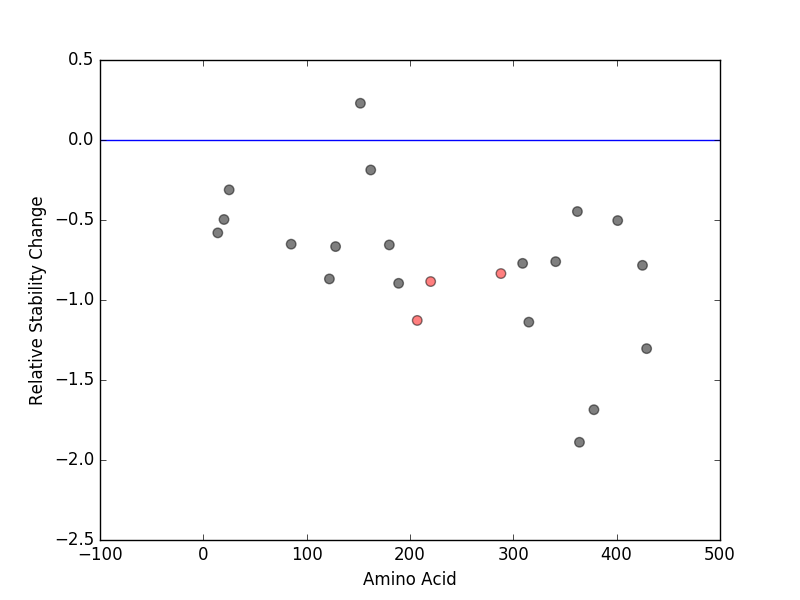
 nsSNVs sorted by the relative stability change of protein structure by each mutation
nsSNVs sorted by the relative stability change of protein structure by each mutation  Structure image for CCNA2 from PDB
Structure image for CCNA2 from PDB Differential gene expression between mutated and non-mutated LBS samples in all 16 major cancer types
Differential gene expression between mutated and non-mutated LBS samples in all 16 major cancer types Differential co-expressed gene network based on protein-protein interaction data (CePIN)
Differential co-expressed gene network based on protein-protein interaction data (CePIN) Gene level disease information (DisGeNet)
Gene level disease information (DisGeNet)  Mutation level pathogenic information (ClinVar annotation)
Mutation level pathogenic information (ClinVar annotation)  Gene expression profile of anticancer drug treated cell-lines (CCLE)
Gene expression profile of anticancer drug treated cell-lines (CCLE)
 Gene-centered drug-gene interaction network
Gene-centered drug-gene interaction network 
 Drug information targeting mutLBSgene (Approved drugs only)
Drug information targeting mutLBSgene (Approved drugs only)
































 Gene-centered ligand-gene interaction network
Gene-centered ligand-gene interaction network 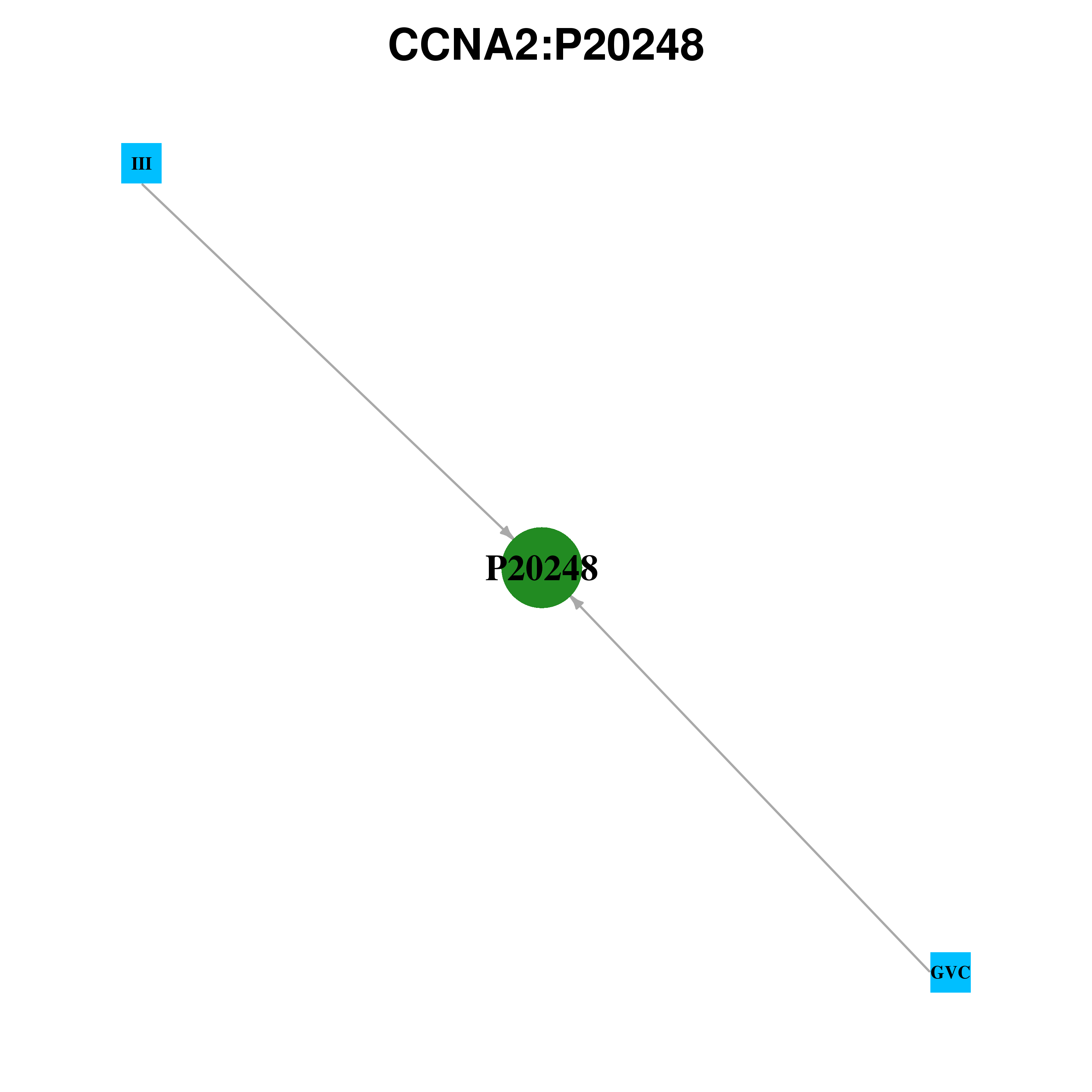
 Ligands binding to mutated ligand binding site of CCNA2 go to BioLip
Ligands binding to mutated ligand binding site of CCNA2 go to BioLip Multiple alignments for P20248 in multiple species
Multiple alignments for P20248 in multiple species 
